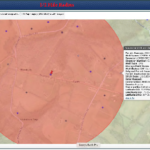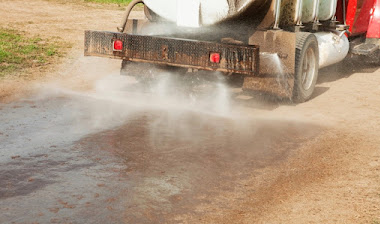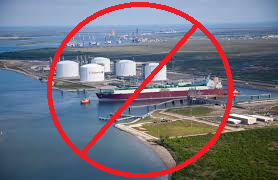
DCS Opposes Proposed Injection Well in Fayette Co., PA
July 29, 2023
Are You Registered to VOTE? DCS Makes it EASY!
August 5, 2023Take A Deep Breath! Now Think What You Just Inhaled. If You Live Along A Dirt Road You Could Be Inhaling Oil & Gas Wastewater.

By Siri Lawson, PA Environment Digest Blog, August 2, 2023
We have dodged this particular bullet here in the Delaware River Basin, thanks in part to the DCS lawsuit that got the DRBC to close a loophole in their regulations governing oil and gas wastewater.
A new Penn State study shows that brine water pumped from played-out conventional oil and gas wells, and used for dust suppression and winter road treatments, is a significant health hazard.
See a map of unpaved roads in PA. These roads are all potential dump sites, except in the Delaware River Basin.
Earlier this year I returned home to find my dirt road was in the process of being “maintained.”
I tried frantically to reach the road crew and ask that the loose dirt piled in the middle of my road be removed instead of spread out and left to blow.
It was too late.
Pennsylvania’s dirt roads are haunted by their legacy as oil and gas waste dumping facilities*.
For decades, rural dirt road residents were spoon-fed assurances that oil and gas wastewater, known as brine, would mitigate the horrendous dirt road dust issues.
We were told the more brine on the road, the better off we would be.
By 2016, dirt road residents in my township of Farmington, were gathering petitions pleading for the road spreading of brine to stop.
Signs saying ‘No Salt Brine, Please!” were springing up along properties.
Those that could stop the brine dumping, the Department of Environmental Protection and township officials, turned a deaf ear to residents.
The singular benefits to the oil and gas industry of cheap waste disposal and the convenience of road dumping production wastes anytime, anywhere, outweighed protests and concerns of dirt road residents held hostage by homes, mortgages and families.
Dirt road residents claimed brine road dumping made dirt roads even dustier.
Often dust would re-appear before a vac truck could finish its spreading run.
Over time we would learn this was scientifically true. Oil and gas wastewater caused chemical, mechanical and physical reactions that massively degraded dirt roads.
The slang term “brine” casts a wide net. It can be formation water, that salty mix most often talked about. But brine also contains a toxic brew of frack fluid, produced water and flowback.
There are fluids from well stimulation and acidization. There are waste fluids to be disposed of when wells are plugged.
Virtually anything that could be put in a vac truck got dumped on Pennsylvania’s dirt roads.
I needed to show that dumping oil and gas wastewater on dirt roads did not suppress road dust.
In 2018, road spreading was halted in many areas of Pennsylvania as a result of a settlement of an Environmental Hearing Board appeal with DEP’s Oil and Gas Program. [Read more here.]
Decades of oil and gas wastewater dumping had turned our township roads orange. Dust clouds produced by traffic were orange tinged.
Dust can injure.
On U.S. Environmental Protection Agency websites there are a number of exposure routes or ways dust contaminants can injure populations or individuals.
Human dust exposure can be by ingestion such as drinking polluted groundwater or eating garden vegetables.
Dust exposure can be dermal, the settling dust making contact with skin, clothes, furniture.
Exposure is oral or by inhalation affecting the lungs or sinuses.
Dust, or worse, brine laden dust, can lodge deep in the airways, making its way from there into the bloodstream.
Dirt roads need to be maintained. Road dirt fills ditches, potholes develop in the traveling surface.
Historically, townships– like my own– have used large graders to reclaim this dirt. The grader blade is angled so ditch dirt is pulled to the center of the road.
This disturbed dirt forms a triangular mound of loose dirt that snakes continuously down the entire length of the road.
Next, it gets flattened by a return trip of the grader.
Townships finish the job by making four or more passes with a York rake.
Left behind, covering the entire road surface, are inches of fluffy dirt that a kitchen broom can turn into choking dust.
Penn State says: “Fugitive dust emissions from dirt and gravel roads are the largest source of particulate matter less than 10 microns (PM10) in the United States.” [Eck, Evaluating Dust Suppressant and ]
Google says Pennsylvania has approximately 17,500 miles of dirt roads that have to be maintained by townships.
Lack of tax dollars means rural townships use the cheapest and easiest method to maintain dirt roads.
For dirt road residents, the dust issue is grim and complicated and leaves them begging for dust control.
The type of road maintenance practices that created the excessive dust also created the platform that allowed the oil and gas industry to commandeer dirt roads as waste disposal sites.
Often the practice was aided by township officials many of whom had connections to the oil and gas industry themselves.
All this was overseen and condoned by the demonstrably pro-oil Department of Environmental Protection.
Although in truth, the regulatory agency had few options to offer either side.
Often, the legislation needed to permit toxic waste disposal on dirt roads seemed to be no further than a campaign contribution away.
The fight over using dirt roads again for disposal of oil and gas wastewater is not over.
The oil and gas industry is moving steadily forward looking for a path to resume this deadly practice of road spreading their production wastes.
The pictures I took in 2017 show the orange, contaminant-filled respirable dust that is airborne when dirt roads are allowed to be brined.
Six years later, the 2023 pictures show the same quantity of respirable dust, but the roads are not brined or treated.
The color shows most of the oil and gas wastewater has been blown or leached out of the respirable dust stream
The difference is, we residents are no longer eating, wearing or inhaling unimaginable amounts of oil and gas wastewater.
The medical websites say humans breathe between 12 and 28 times a minute. We take over 20,000 breaths a day.
It is inconceivable that once again legislators, the township officials, the Department of Environmental Protection and even the oil and gas industry would again allow the dust stream that dirt road residents must coexist with to be laden with deadly, toxic, ruinous brine.
*Note: DEP adopted regulations banning the road dumping of unconventional shale gas wastewater on roads in 2016. Wastewater from conventional oil and gas wells could still be dumped on dirt and gravel roads if they meet the requirements of the Residual Waste Regulations. So far, no operators have, but the practice has not been banned for conventional drillers and is still happening.



